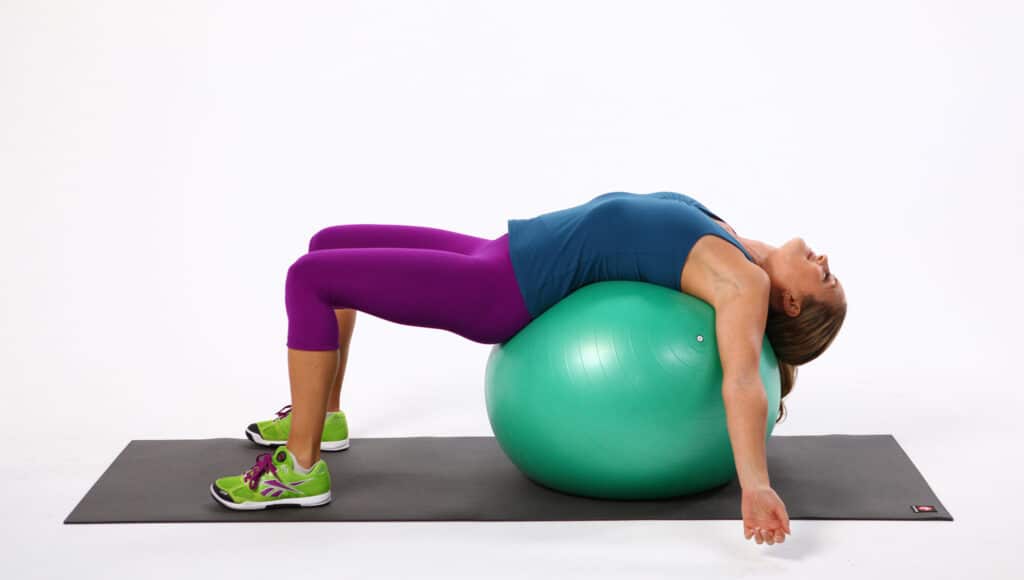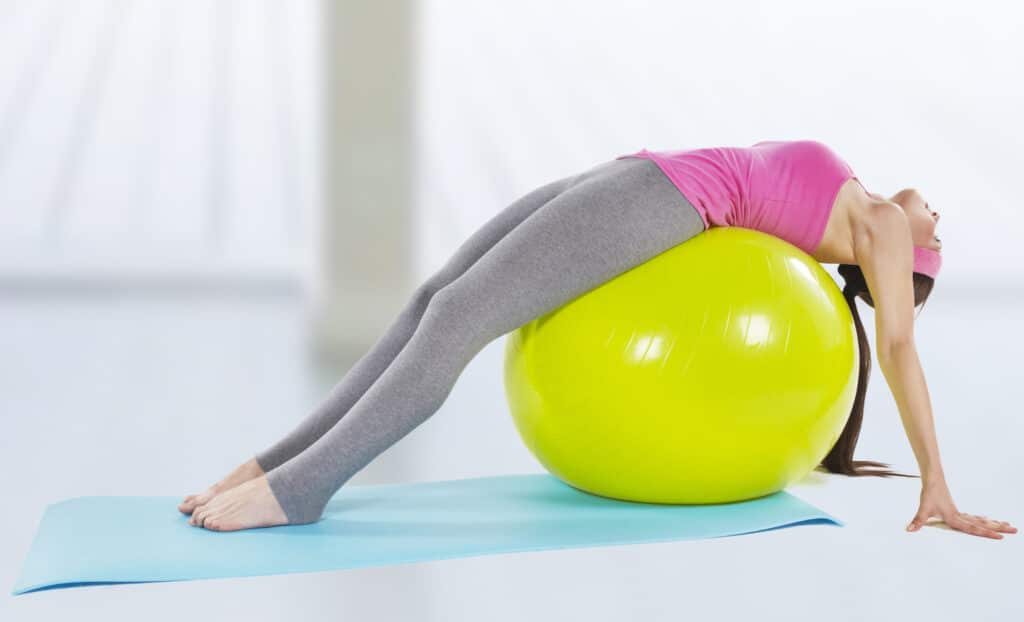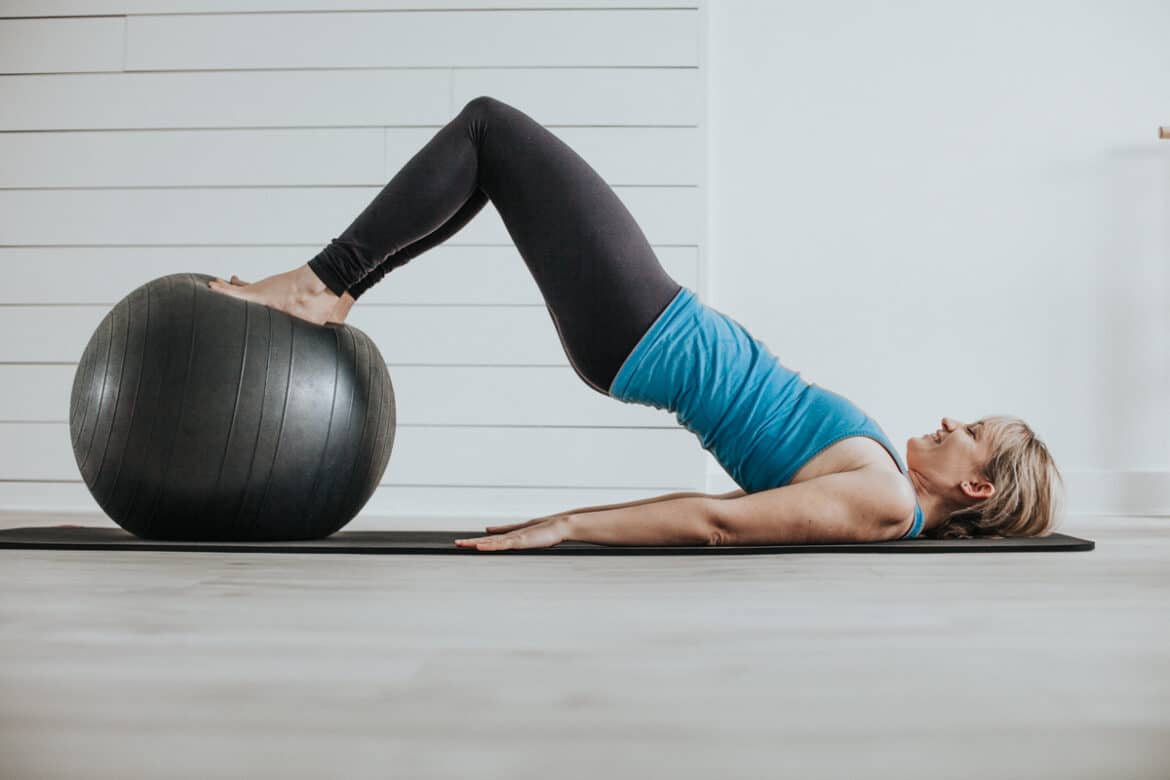Introduction
What Is A Pilates Ball: The Pilates ball, originally developed by Joseph Pilates as part of his revolutionary Pilates method in the early 20th century, has become an essential tool in modern fitness and rehabilitation. Its design allows for a wide range of exercises that engage various muscle groups, making it particularly effective for targeting the core muscles, which are crucial for maintaining good posture and preventing back pain.
One of the key benefits of incorporating a Pilates ball into your fitness routine is its ability to provide an unstable surface, requiring you to engage your stabilizing muscles. This instability forces your body to work harder to maintain balance, which, over time, can lead to improved coordination, increased strength training, and enhanced flexibility. The Pilates ball is gentle on the joints, making it an excellent choice for individuals of all fitness levels, including those recovering from injuries or dealing with joint issues.
A Pilates ball, often referred to as an exercise or stability ball, is a versatile fitness tool that has gained popularity for its wide range of applications in both Pilates and general exercise routines. This inflatable, typically spherical ball is made of durable materials and comes in various sizes to accommodate different body types and fitness levels. Its primary purpose is to enhance core strength, stability, flexibility, and overall balance.

Is a Pilates ball weighted?
Weighted Pilates Balls are very handytools when used in Pilates exercises. Easy to hold weights, these weighted balls can be used to help maintain alignment in certain exercises.
Core Strength: A non-weighted Pilates ball is highly effective in building core strength. By working to stabilize your body on the ball, you engage deep abdominal muscles, obliques, and lower back muscles.
Balance and Stability: The inherent instability of the Pilates ball forces your body to work harder to maintain balance. This can lead to improved coordination and enhanced stability over time.
Flexibility: Pilates ball exercises often involve stretching and lengthening the muscles, promoting flexibility and range of motion.
Gentle on Joints: These balls provide a low-impact workout, making them suitable for individuals with joint issues or those in various stages of fitness.
Versatility: Pilates balls can be used for a wide range of exercises, from core-focused movements to full-body workouts, making them a versatile addition to any fitness routine.
A Pilates ball, often referred to as an exercise or stability ball, is a versatile fitness tool that has gained immense popularity for its ability to enhance core strength, stability, flexibility, and overall balance. However, a common question that arises among fitness enthusiasts is whether a Pilates ball is weighted.
What can I use instead of a Pilates ball?
Small pilates ball
For those who like to use a small workout ball during sweat sessions, Nolden says she uses a circular pillow that provides a similar result. Or, if you don’t have a pillow that works, roll up a towel and use that instead.
A yoga block is a versatile prop used in yoga practice, but it can also be used as a substitute for a Pilates ball. You can place a yoga block between your thighs or knees during exercises that require squeezing the ball. This can help engage the inner thigh muscles and replicate some of the resistance provided by a Pilates ball.
A cushion or pillow can be used as a makeshift replacement for a Pilates ball, especially for exercises that involve sitting or lying down. You can place the cushion or pillow between your legs or under your lower back to add resistance and support during exercises.
Resistance bands are excellent for targeting various muscle groups, including those that benefit from Pilates ball exercises. You can use a resistance band to replicate the resistance and tension typically provided by the ball. For example, you can perform seated or lying leg lifts while looping a resistance band around your feet and holding the ends with your hands.
A foam roller can serve as a substitute for a Pilates ball in exercises that require balance and stability. You can perform exercises like planks or bridges with your feet resting on a foam roller to challenge your core muscles and improve balance.
What is a Pilates ball called?
The ball is also known by various other names, for instance: balance ball, birth ball, body ball, fitness ball, gym ball, gymnastic ball, physio ball, pilates ball, Pezzi ball, stability ball, Swedish ball, Swiss ball, therapy ball, or yoga ball.
Pilates Ball: The most common and straightforward name for this fitness accessory is simply the “Pilates ball.” It is often used in Pilates workouts and exercises to enhance core strength, balance, flexibility, and stability. In this context, it is typically a non-weighted inflatable ball made from durable materials like PVC or rubber.
Exercise Ball: The term “exercise ball” is a broader designation that encompasses a wide range of fitness applications beyond Pilates. These balls are used for general exercise routines, core workouts, stretching, balance training, and even rehabilitation exercises. Exercise balls are available in various sizes and materials to accommodate different fitness levels and needs.
Stability Ball: The name “stability ball” emphasizes one of the key benefits of using this fitness accessory. Stability balls provide an unstable surface that challenges the body’s balance and engages core and stabilizing muscles. They are often used in physical therapy and rehabilitation to improve stability and mobility.
Swiss Ball: The term “Swiss ball” is less common but is sometimes used interchangeably with “exercise ball” or “stability ball.” This name is believed to have originated from the Swiss physiotherapists who first used these balls for rehabilitation purposes in the 1960s. It has since become a widely recognized term in the fitness industry.
Yoga Ball: Although primarily associated with yoga, the “yoga ball” can refer to the same fitness accessory as a Pilates or exercise ball. In yoga, it is used to support and enhance various poses and stretches, as well as to improve balance and alignment.
What are the benefits of Pilates balls?
Pilates balls is ideal to train those hard to reach muscles that fail to get trained in the gym, lifting weights or equally superficial workouts. Pilates balls also add resistance to exercises, many of which encourage pelvic floor activation as well as toning the body.
Improved Core Strength: One of the primary benefits of Pilates balls is their ability to target and strengthen the core muscles. When you perform exercises on a Pilates ball, your body must engage its core muscles to maintain balance and stability. This constant activation of the core helps develop a strong and toned midsection.
Enhanced Stability and Balance: The unstable surface of a Pilates ball challenges your balance and stability. Regular use can lead to improved proprioception (awareness of your body’s position in space) and better balance, which is especially beneficial for athletes and older adults looking to reduce the risk of falls.
Increased Flexibility: Pilates ball exercises often involve stretching and lengthening the muscles. This promotes flexibility and range of motion in various muscle groups, helping to prevent injuries and improve overall mobility.
Better Posture: Pilates ball exercises encourage proper alignment and posture. As you engage your core and maintain balance on the ball, you naturally develop better postural awareness, which can translate into improved posture in daily life.
Are Pilates balls soft?
Also known as exercise balls, stability balls, or Swiss balls, these soft balls are versatile and can be used to target specific muscle groups, improve balance and coordination, and increase core strength.
Pilates balls are typically made from soft yet durable materials like PVC (polyvinyl chloride) or rubber. These materials offer a certain degree of flexibility, allowing the ball to give and compress when pressure is applied. This characteristic gives the ball its softness, making it comfortable to use for a wide range of exercises.
One of the defining features of Pilates balls is that they are inflatable. Users can adjust the level of inflation to control the firmness or softness of the ball. When the ball is fully inflated, it tends to be firmer, offering more stability for exercises that require balance and support. Conversely, when the ball is slightly under-inflated, it becomes softer, providing a more yielding surface for exercises that involve lying or sitting on the ball.
The size of the Pilates ball also plays a role in its softness. Smaller balls, such as those with a 45-centimeter diameter, tend to be softer because they have less air volume. Larger balls, like those with an 85-centimeter diameter, can be inflated to a higher pressure, making them firmer. Users can choose the size that best suits their comfort and fitness goals.
The level of softness of a Pilates ball often depends on its intended use. For instance, balls designed for rehabilitation and physical therapy purposes may be softer to provide gentle support for individuals recovering from injuries. On the other hand, balls intended for advanced Pilates or fitness routines may be slightly firmer to provide stability during challenging exercises.
What size ball is used in Pilates?
The most popular sizes for group classes are 55 cm and 65 cm, as the majority of users fall between 5’1” – 6’1” tall. However, be sure to grab a few 45 cm diameter stability balls for youth programming and a few 75 cm stability balls to accommodate users over 6’2”.
Small (45 cm): A small Pilates ball, typically measuring around 45 centimeters (approximately 18 inches) in diameter, is often used for precision work in Pilates. It’s excellent for targeting specific muscle groups, especially the deep stabilizing muscles of the core. Smaller balls are also favored for pelvic floor exercises and can be used for added resistance in leg and arm movements.
Medium (55-65 cm): Medium-sized Pilates balls, ranging from 55 to 65 centimeters (approximately 22 to 26 inches) in diameter, are versatile and suitable for a wide range of exercises. They provide a balance between stability and mobility, making them a good choice for core work, balance training, and stretching exercises. Many individuals find medium-sized balls comfortable for seated or lying-down exercises.
Large (75-85 cm): Larger Pilates balls, with diameters between 75 and 85 centimeters (approximately 30 to 34 inches), are often used for exercises that require stability and support, such as exercises that involve lying or sitting on the ball. They are excellent for enhancing balance and are commonly used in rehabilitation and physical therapy settings. The larger size provides a stable base for various movements.
If you’re new to Pilates or have limited experience with stability balls, it’s advisable to start with a medium-sized ball. This size offers a good balance of stability and mobility, making it suitable for beginners.
Is it good to sit on a Pilates ball?
Sitting on a stability ball requires active engagement of the core muscles because you don’t have any back support, Chan says. While this position can be good for improving your posture and core stability, as soon as you relax, your posture suffers, which can ultimately lead to aches and pain.
Improved Posture: One of the primary advantages of sitting on a Pilates ball is that it promotes better posture. The instability of the ball encourages you to engage your core muscles and maintain an upright position. Over time, this can help reduce the risk of slouching and improve overall spinal alignment.
Core Engagement: Sitting on a Pilates ball continuously engages your core muscles as you work to stabilize yourself. This low-intensity workout can contribute to better core strength and endurance over time.
Active Sitting: Unlike traditional chairs that promote passive sitting, using a Pilates ball encourages active sitting. Active sitting means you are constantly making micro-adjustments to maintain balance, which can help prevent the negative effects of prolonged sitting, such as muscle stiffness and reduced circulation.
Variety and Mobility: A Pilates ball allows for dynamic movement while sitting. You can gently bounce, sway, or shift your weight, which can help alleviate stiffness and promote circulation during long periods of sitting.
Spinal Health: Sitting on a Pilates ball may reduce the risk of developing back pain or discomfort associated with prolonged sitting in traditional chairs. The dynamic nature of the ball encourages spinal movement and prevents the static posture that can lead to back problems.
Is Pilates heavy exercise?
It may also help correct muscle imbalances and promote relaxation. Pilates is a form of very light resistance training. It’s more active than yoga but less intense than jogging, running, cycling, and other aerobic activities.
Core Emphasis: Pilates places a significant emphasis on strengthening the core muscles, including the abdominals, obliques, and lower back. Core work is a fundamental aspect of Pilates, and many exercises target these muscle groups.
Low-Impact: Pilates is generally considered a low-impact exercise. It is designed to be gentle on the joints, making it suitable for individuals of various fitness levels, including those with joint issues or injuries.
Controlled Movements: Pilates exercises are characterized by slow, controlled movements that require precision and concentration. This controlled approach helps improve muscle strength, stability, and flexibility.
Flexibility: Pilates incorporates stretching exercises to enhance flexibility and range of motion. These stretches are often integrated seamlessly into the routines.

Conclusion
The Pilates ball, also known as an exercise or stability ball, stands as a dynamic and adaptable fitness accessory that has evolved from its origins in the Pilates method to become a valuable tool in modern exercise and rehabilitation. Its inflatable design, available in various sizes, offers a wide range of benefits for individuals of all fitness levels. By promoting core strength, stability, flexibility, and balance, the Pilates ball enables enthusiasts to achieve a more resilient and agile body.
This versatile fitness tool’s ability to create an unstable surface engages Pilates ball stabilizing muscles, leading to improved coordination and strength. Moreover, its gentle impact on joints makes it an accessible option for those in various stages of physical fitness or recovery from injuries. Whether you are a seasoned fitness enthusiast or just embarking on your wellness journey, the Pilates ball offers an engaging and effective means of enhancing your workouts and achieving your fitness goals.
The various exercises and techniques that can be performed with it, from core-strengthening movements to balance and flexibility exercises. Whether you’re seeking to develop a stronger core, improve your posture, or simply add an exciting dimension to your workout routine, the Pilates ball is a versatile and accessible tool that can help you achieve your fitness goals while adding an element of fun to your exercise regimen.

